A Walking Tour Through Paradise
Novelist Sarah Stonich teams up with artist Mickey Smith for a photo-essay on this year's iteration of "headland Sculpture on the Gulf," a contemporary public sculpture biennial in New Zealand.
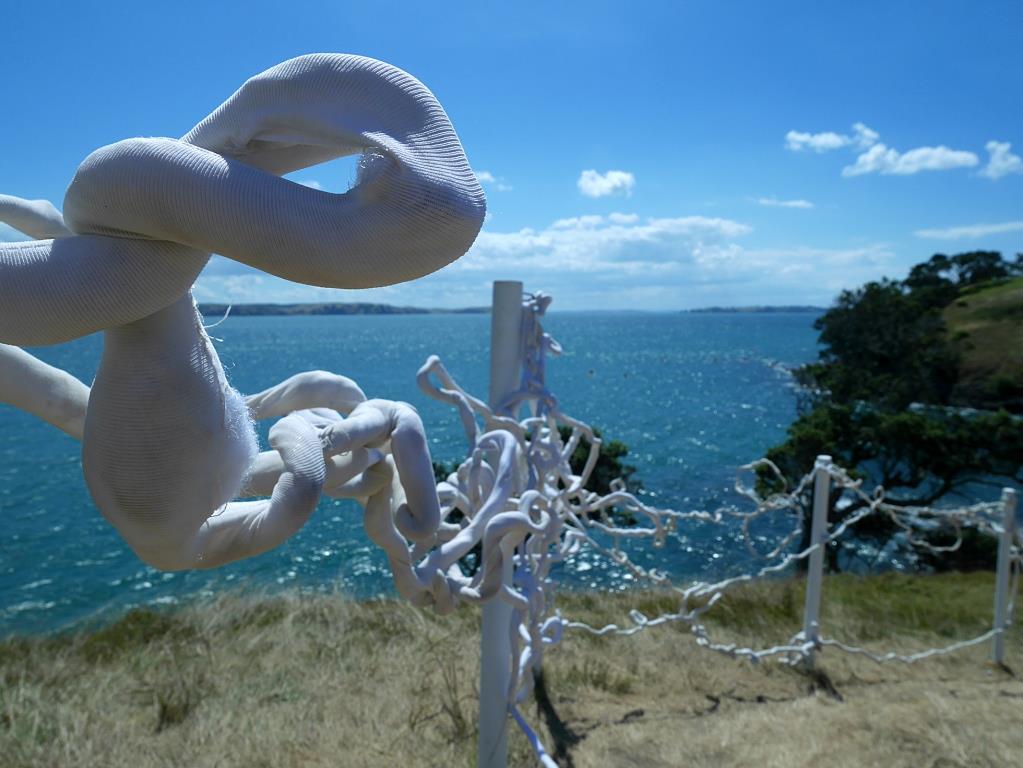
Waiheke Island is a swift 20-minute ferry from downtown Auckland. We are traveling to the headland Sculpture on the Gulf biennial exhibit, established in 2003 by the Waiheke Community Arts Gallery. My companion is photographer Mickey Smith, a Minnesota transplant to New Zealand and, as it happens, my niece.
As we sail into Matiatia Bay, my attention is torn between competing sights – like most anywhere in this country, the views defy description. With every hill crested or curve navigated comes a danger of sensory overload: you think you’ve just seen the most gorgeous beach in the world, and then—bam—here’s another that trumps it. By day’s end a sort of paradise-itis sets in. And that’s just on the North Island, considered the plain sister as sibling islands go.
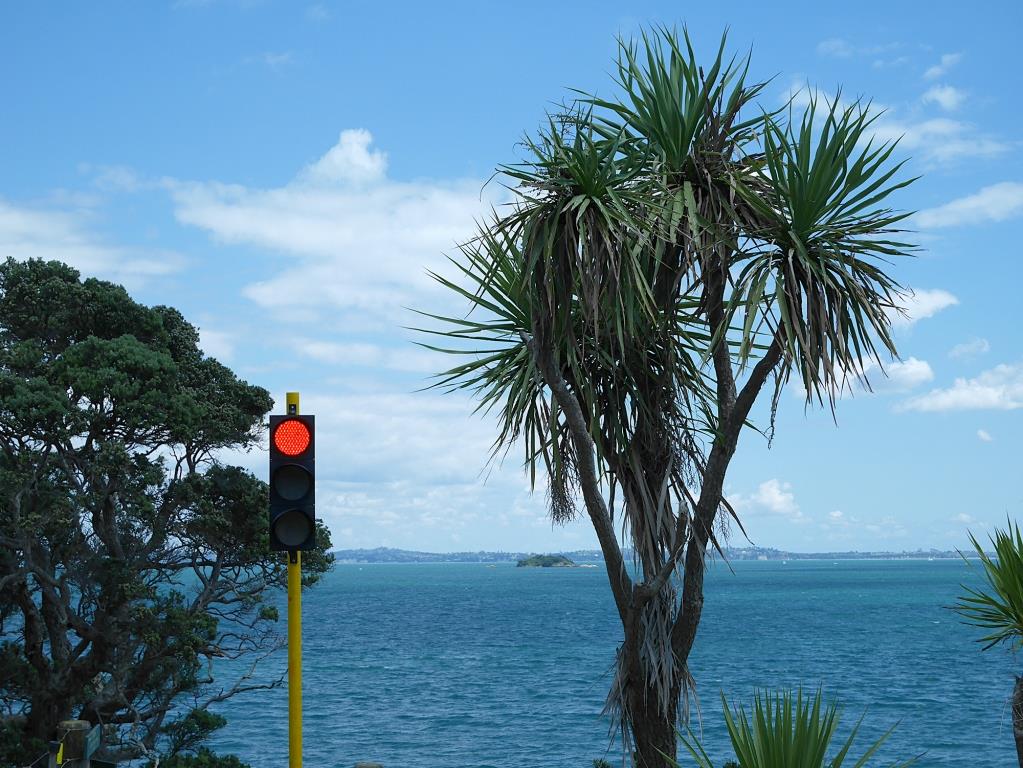
Even aboard the ferry, there is a lot to take in, from the quality of the air to the shifting hues of the water, which vary from Ty-D-Bol blue to Scope to deep navy; the foliage is out of Jurassic Park. Scattered across the hills in the distance are the sorts of design-driven glass houses that you see in glossy architectural porn.
Now, throw in 31 pieces of mostly large-scale, outdoor sculpture. The challenge with this exhibition is its very location; those pieces standing most in opposition to their surroundings succeed best. It’s as much about materials as form: bold pieces crafted of synthetics and metals—like stainless steel, or aluminum alloy enameled in toy colors—are best able to pry the eye away from some 10-foot fern you’ve never seen the likes of, or a glittering cove bobbing with yachts. The more subtle pieces carry less of a wallop through no fault of their own.
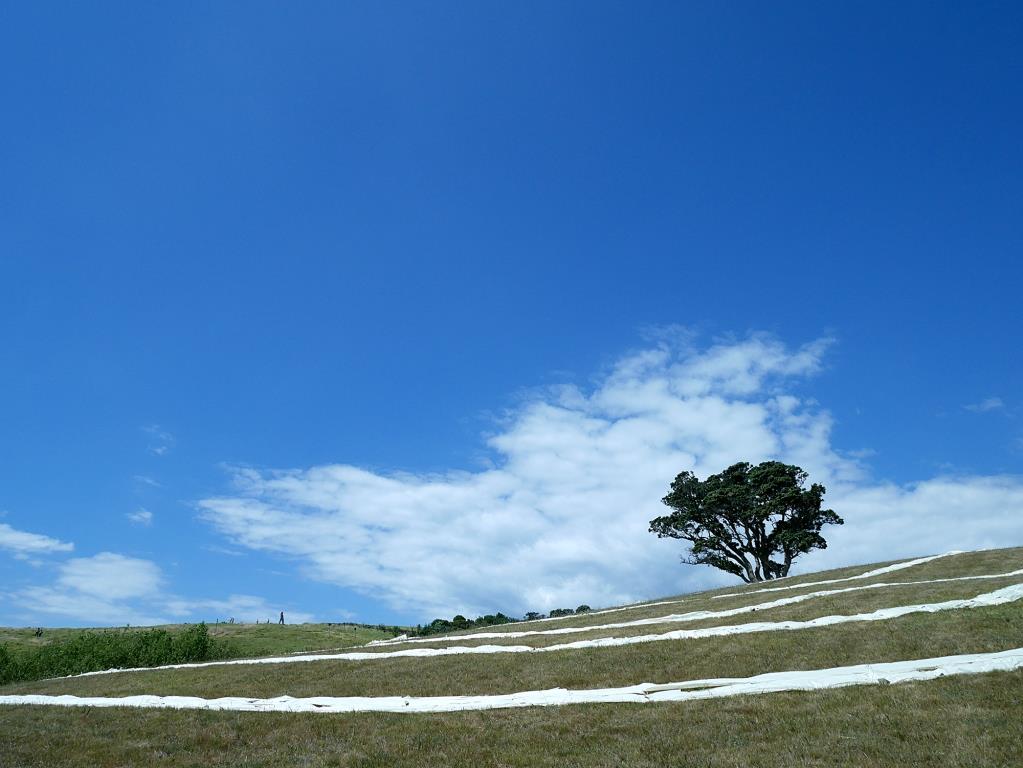
From the bay, one of the most visible sculptures, Landform, draws your attention to a set of concentric circles which at first appear to be white canvas or plastic; get closer, and you see the rings are actually made of various widths of masking tape stapled onto the mowed hillside—lots of masking tape. Artist Veronica Herbert was interested in “creating a piece that would be seen from the ferry so the connection to the land would begin even before the viewer reaches solid ground.” Indeed, Landform is more effective from afar. As with many of the sculptures on view, distance is an integral component.
Since its inception, headland Sculpture on the Gulf has upped its attendance with each consecutive biennial event. Over the course of this exhibition, about 55,000 viewers walk through the venue—impressive, considering it’s only up for only three weeks, it’s on an island, and its length stretches just over a mile on a path uneven enough to discourage anyone old, infirm, or fearful of heights. Organizers recommend a ‘moderate level of fitness’ and sturdy footwear. Those who forgo the walk can hang in the event tent at base camp where a makeshift gallery features small pieces by featured artists. The word walk suggests a stroll, which it is not. I discovered the New Zealand definition of ‘hill’ is more than a few degrees steeper than the bumps we claim here in the Midwest. I move slowly along the path, using hiking poles, having recently taken a bad tumble; I’d like to claim the resulting psychedelic bruises were trophies from my hike on the Queen Charlotte Track, but I was actually just trying to swat at a mosquito in the comfort of my room when I crashed.

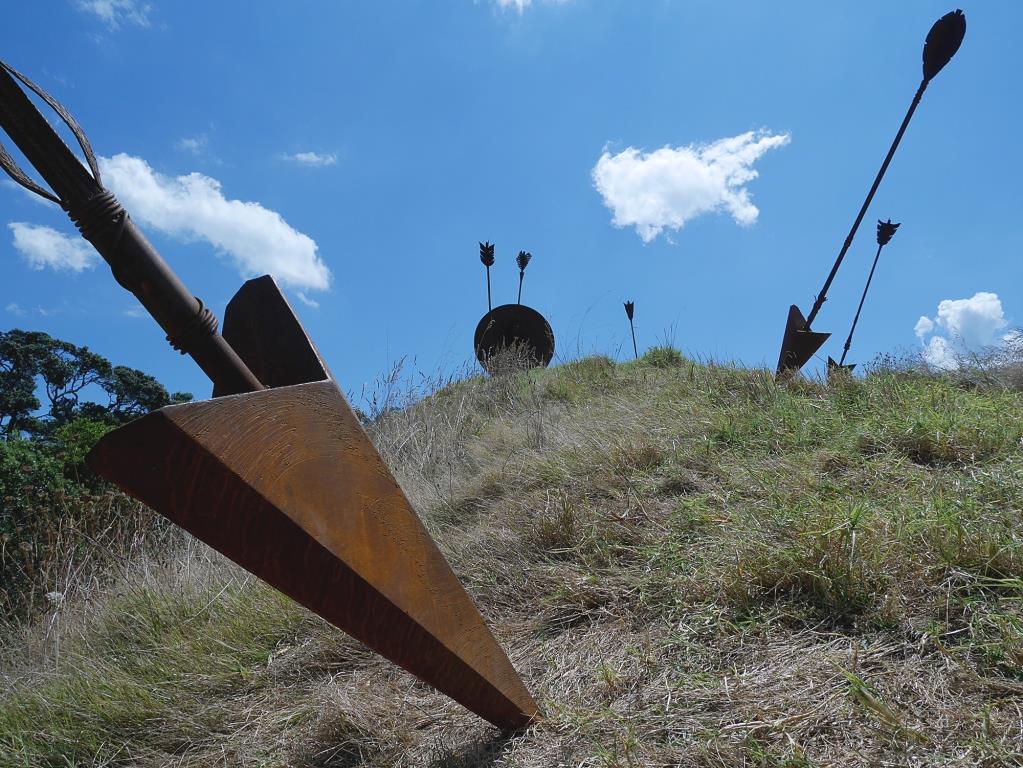
This biennial exhibit tips in favor of New Zealand artists, but it could hold more international potential —if it wanted to. This is a remote country, the size of Minnesota and with similar population. Its first settlers were Maori and Pacific Islanders, then, fairly late in the game as colonization went, came the British and whoever else. Currently there’s much interest by wealthy Asians and an influx of Pacific Rim cash arriving on that swell of immigration which is beginning to result in consequences for established Kiwis, inflating housing prices and cost of living. In a previous year’s exhibit, a large slope of land was embossed with letters spelling out “Not For Sale.” It’s a sentiment that seems, if not often voiced, to permeate the collective consciousness.
The Fuller’s People’s Choice Award (Fuller’s is one of two giant ferry services in a country where a daily commute for many includes a ferry ride) went this year to artist James Wright for Target. Indeed, its theme of perseverance makes it a very approachable piece. Constructed of steel and tensile rod, a number of four-foot-long arrows pierce the ground, missing the mark by a good margin, but the winning shot is a precise bulls-eye. Wright says the arrows “are a reminder that you need to be strong to overcome those shortfalls.”
Up the track, standing on a rise is a layered, one-dimensional steel likeness of James Bond (Sean Connery’s version) taking a selfie in a piece titled My Pic Is My Bond – this seems a crowd favorite and, naturally, many people stop to take a selfie next to Bond taking a selfie. As did I.
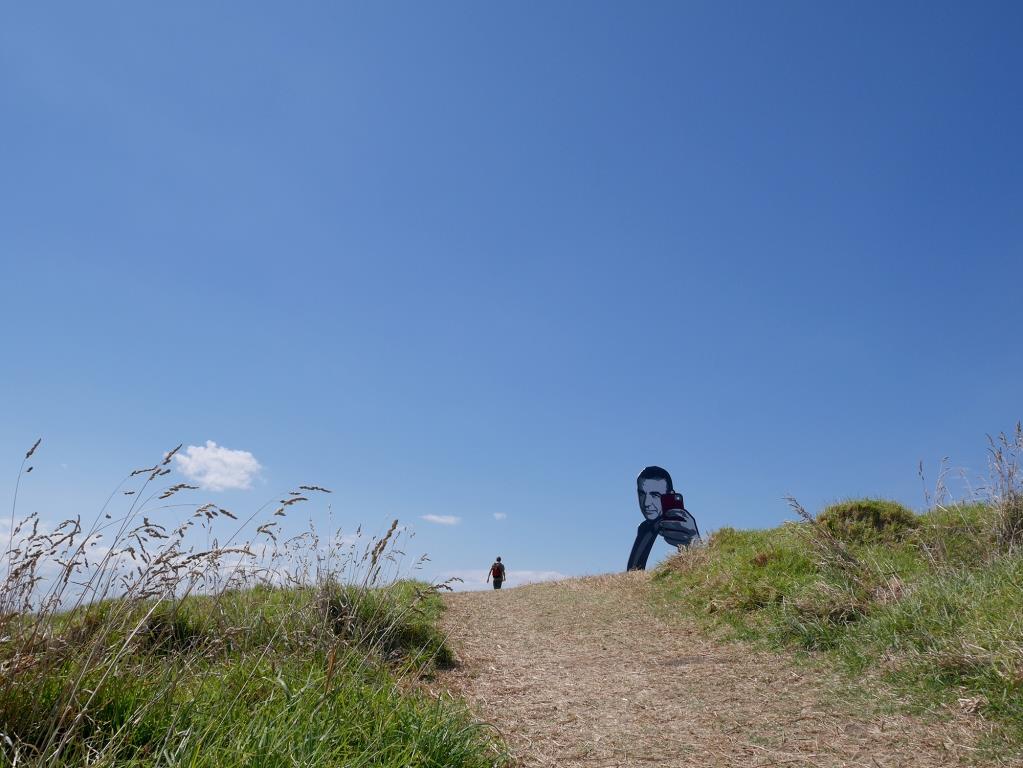
A copse of 36 large, mirrored columns sprouting on a grassy hillside are striking and a bit alarming for the fact that they are glass, swaying some in the breeze and shuddering in the wind. Field Apart is all about reflection, much like Cloud Gate in Chicago (you know, the Bean.) The ever-changing conditions of light, motion, and weather complete the piece. It is where it is, quite literally.
People like to touch art when they aren’t supposed to – we’ve all seen it – but when encouraged to, many grow wary. Audrey Boyle’s interactive fence the knot and the knot now invites viewers to a tactile experience with her fence of Dacron fabric, wire, and posts. She says, “Knots – moments of physical tension can act as a metaphor for any number of psychological states. This fence invites you to tie your own knots in order to untie those of the past.” I only saw kids and a few old ladies go for it.
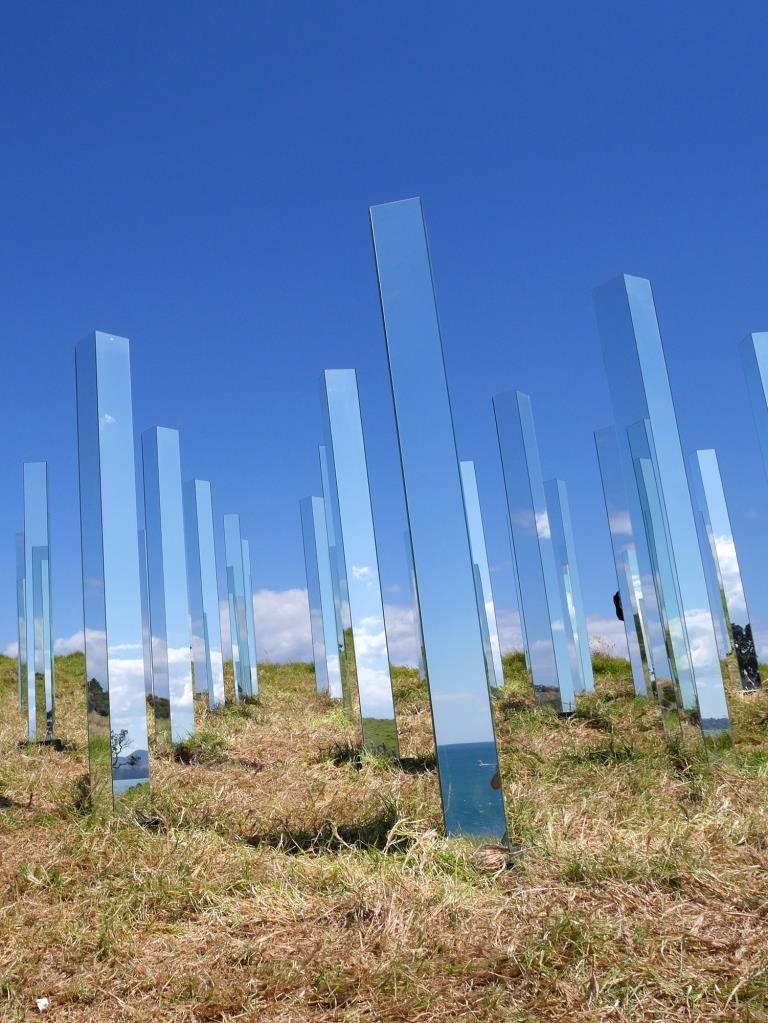
Sun on the trail is fierce. Drooping walkers gather in patches of shade, most of them down to their last few sips of water. I speak with a teacher and an architect from Wellington who, upon learning I’m from Minnesota, perk up to ask if I know that radio show Prairie-House-Something, and don’t I just love it? I sigh, just as they must when visitors associate them with All Things Hobbit.
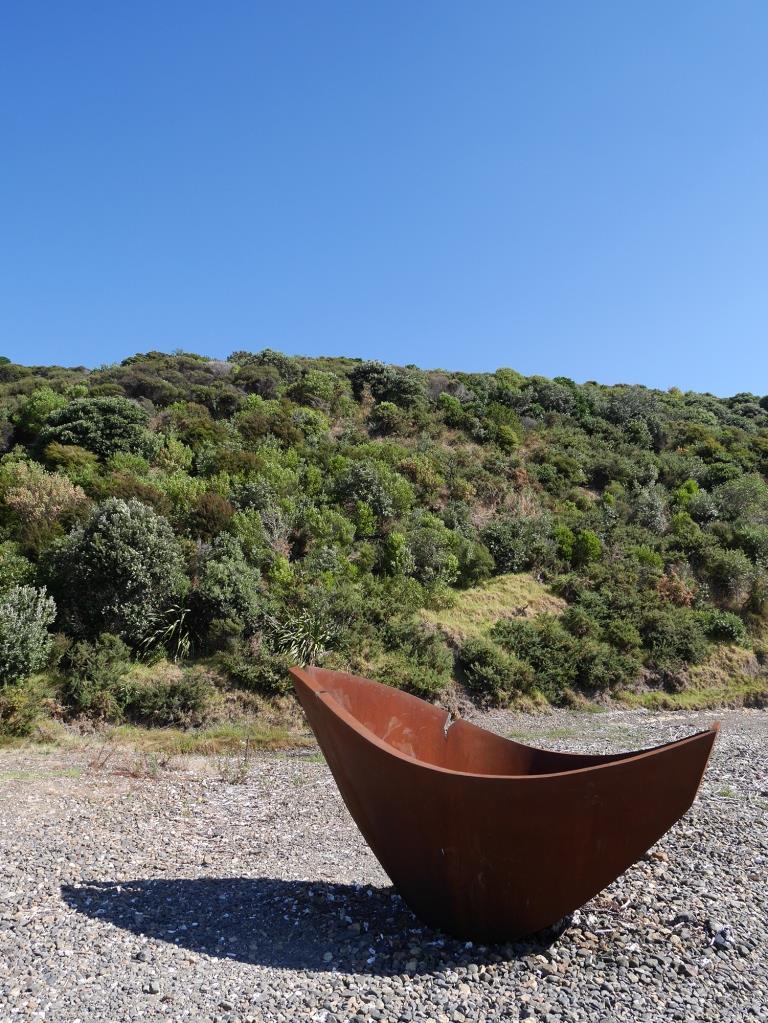
Two final pieces in this year’s headland Sculpture on the Gulf well represent two cultures that have coexisted here peaceably enough and long enough to define New Zealand as it is. The first, Return the Manuruhi staggers fifteen carved Maori figures seaward to appear and disappear with the tides, recalling tribal discord between two mythic gods—the abduction of a son, and the ensuing retribution. The next, Massive Vessel is a stylized, oxidized steel dory which, intentional or not, resonates distinctly like a historic reference to Atlantic seafarers settling on this Pacific idyll, which is a breathtaking sculpture in itself.
Related information:
Find out more about New Zealand’s headland Sculpture on the Gulf biennial on Waiheke Island on the exhibition event website: http://sculptureonthegulf.co.nz/.

Minneapolis writer Sarah Stonich is the author of These Granite Islands, and Vacationland.
Mickey Smith is a conceptual artist and photographer. She received a BA in Photography from Minnesota State University Moorhead in 1994. Works from her Volume series have exhibited throughout the United States, Europe, China and Russia. Smith’s work is held in numerous public and private collections, including the Weisman Art Museum, Sheldon Museum of Art and Museum of Modern Art Library. Smith has received a McKnight Photography Fellowship as well as grant awards from Forecast Public Art Affairs, CEC ArtsLink and the Lower Manhattan Cultural Council. Her first major public art commission was selected as one of the 40 best permanent public art works in the United States by Americans for the Arts in 2010. Smiths’ photographs have appeared in several publications including ESOPUS, Theme, The Last Magazine, GQ, and on the covers of PDNEdu and Photography Quarterly. Her first artist’s book, Denudation, published by Hassla, was included in the photobook installation exhibited in A Different Kind of Order: The International Center for Photography Triennial. She lives with her family in New Zealand and is represented by Invisible-Exports in New York. In August 2015, she will present her first major video installation at Te Tuhi Centre for the Arts in Auckland.